Humans have always been curious about the sky and what is beyond it. As gradually as the knowledge about the universe increased, so did curiosity. For hundreds of years people have been fascinated by the stars, moon, planets and sun.

One of the most fascinating and mysterious phenomena is black holes in the universe. These are the regions in the universe which have strong gravity which engulfs everything, even the light. This intense gravity is created mostly by the collapse of a star accumulating concentrated mass at a small region.
Event horizon:
Event Horizon is the boundary around the black hole which is usually defined as the Point of no return. Any matter or information once passes through it will be lost forever. It is impossible to escape the gravitational pull of black hole.
It is an imaginary boundary around black hole which marks the limit of influence of black holes.
Can anything escape a black hole?
The escape velocity of black hole is equal to the speed of light which means an object has to travel with the speed of light to escape a black hole which seems impossible according to our current knowledge of physics. It is a region where the laws of physics are stretched to its limits and it is an area where still active research is going on.
How time and space change in black holes?

Einstein's Theory of General Relativity:
According to Einstein's theory of general relativity, time slows down as matter approaches the Event Horizon, stopping altogether at the boundary. breaking down
Hawking Radiation:
According to Stephen Hawking who was a theoretical physicist Event Horizon emits radiation due to quantum effects near the boundaries which is called Hawking Radiation. This means black holes eventually lose their mass and evaporate completely.
Singularity:
It's the centre of black hole where all the masses which are passed in it are accumulated. It is a point of infinite density and zero volume.
Categorization of black holes according to their sizes:
- Stellar-mass black holes:
They are formed by the gravitational collapse of gigantic stars. They are created when a star of heavy mass undergoes a supernova explosion at the end of its life cycle resulting in the formation of black hole. Their mass may range from 5 to several tons of solar masses. It's a fascinating object representing the end point of a massive star.
- Supermassive black holes:
As the name suggests they are super massive black holes which have masses of millions to billions of times greater than the sun's mass. They are still shrouded in mystery, challenging our understanding of physics. Mostly they are found at the centre of galaxies. A super massive black hole named Sagittarius A is present in our own milky way. The reason for this type of black hole formation is still not clear till date. Although they play an important role in the dynamics of their host galaxies.
- Intermediate mass black holes:
The intermediate black holes usually fill the gap between stellar mass black holes and supermassive black holes. They are not yet confirmed black holes. They are expected to have mass significantly higher than stellar mass black holes but lower than millions to billions of solar masses found in supermassive black holes. Its presence is evident by the velocities of gas clouds and the spectra of accretion disk around these objects. A theory suggests that they are formed as a result of the merging of multiple stellar-mass black holes. Another theory suggests they are formed in the heart of dense star clusters where collision and merging of smaller black holes occurs.
Images made on Canva Pro
This post is on the topic given in the prompt of the month of June and here is the link if you want to write on the topics given in the prompts.
